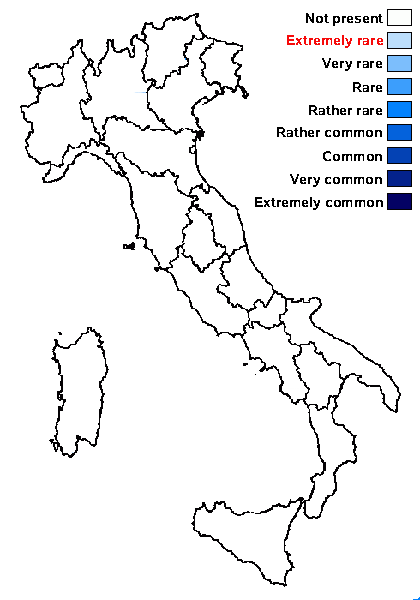Protoblastenia rupestris subsp. rhodothecia Cl. Roux
Bull. Soc. Linn. Provence, 54: 121, 2003.
Synonyms:
Distribution:
Description: Thallus crustose, episubstratic, rimose to areolate, grey to olivaceous brown. Areoles angular, flat to slightly convex, up to 0.5 mm wide. Apothecia frequent, scattered to crowded, sessile and not constricted at base, (0.3-)0.4-0.7(-0.8) mm across, blood-red, flat to usually moderately convex, K+ red to violet, the margin indistinct, becoming excluded. Proper exciple thin, colourless to patchily pale orange, with parallel-radiating hyphae; epithecium orange to brown-orange, with granular crystals reacting K+ red; hymenium colourless to pale yellow, 70-120 µm high, hemiamyloid; paraphyses coherent, branched and anastomosing, 2-4 µm thick, the apical cells slightly swollen; hypothecium faintly blood-red, patchily pigmented. AAsci 8-spored, elongate-clavate, with a thin, outer amyloid layer and a thickened tholus penetrated by a tube, the sides of which stain I/KI+ deep blue, Porpidia-type. Ascospores 1-celled, hyaline, ellipsoid to ovoid, (9-)11-14(-17) x (5-)6-8(-9) µm, without a distinct perispore. Photobiont chlorococcoid. Spot tests: thallus K-, C-, KC-, P-; apothecia K+ red. Chemistry: apothecia with anthraquinones. Note: on superficially decalcified calcareous rocks (ecology similar to that of Stenhammarella turgida) in alpine environments; recorded with certainty only from France, but perhaps not recognised elsewhere; to be looked for in the Italian Alps.
Growth form: Crustose
Substrata: rocks
Photobiont: green algae other than Trentepohlia
Reproductive strategy: mainly sexual

Predictive model
Growth form: Crustose
Substrata: rocks
Photobiont: green algae other than Trentepohlia
Reproductive strategy: mainly sexual

Predictive model
 Index Fungorum
Index Fungorum
 GBIF
GBIF

